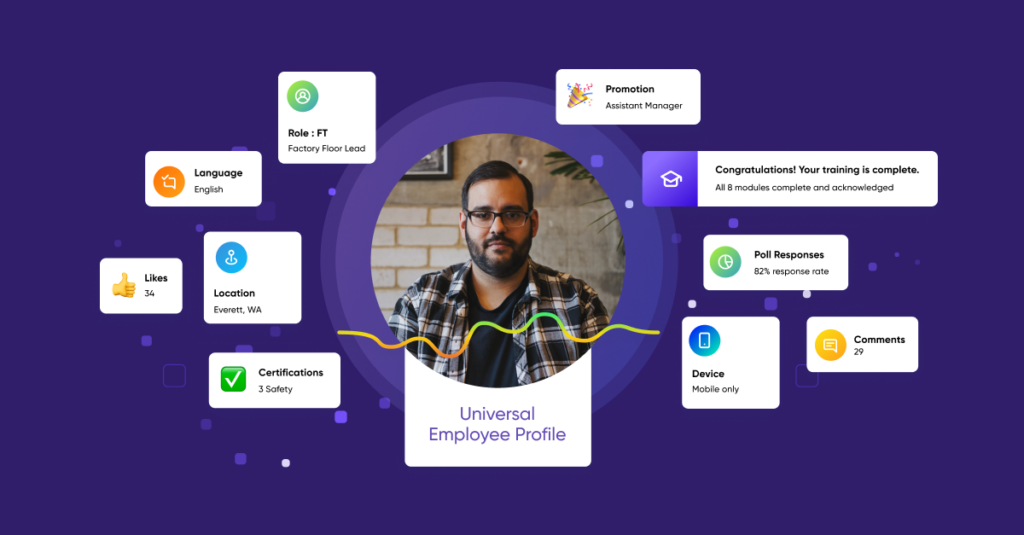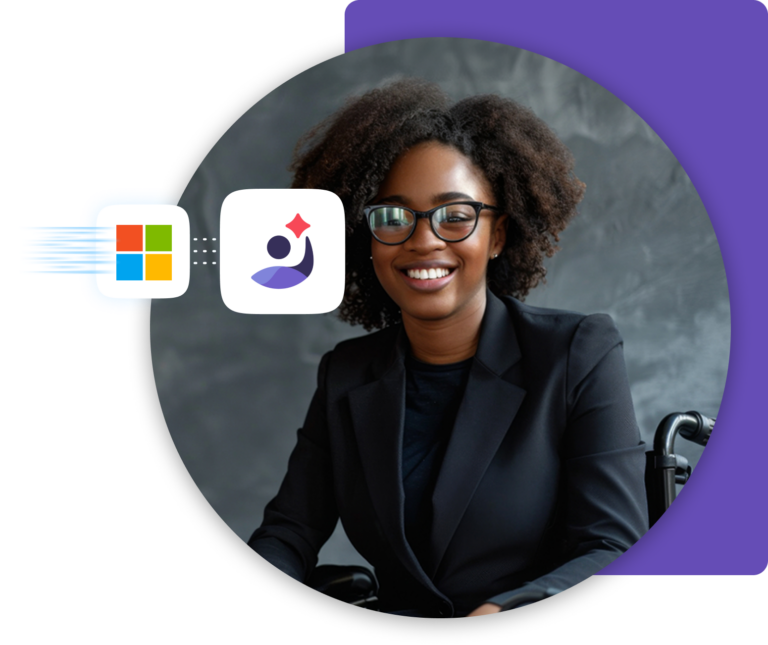In the contemporary workplace, the importance of accurate, robust employee data cannot be overstated. Its role in HR and internal comms extends beyond executing standard workforce-related processes to shaping a positive employee experience that fosters employee loyalty, productivity, and satisfaction.
From targeted communication to personalized moments along the employee journey, employee data is the foundation of your efforts to elevate the employee experience.
In this blog post, we’ll discuss how HR and internal communications can make an impact on employee engagement by tapping into the wealth of employee data contained in your employee platforms and putting it to work for your workers.
The best part: You can stop updating those dreaded distribution lists to supposedly target your employee communication. Through AI-powered intelligent communication platforms, gone are the days of email distribution lists. It’s time to embrace the future using employee data.
Data is the starting point for increasing engagement
Just as businesses strive to enhance the customer experience, organizations are now realizing the importance of creating an exceptional experience for their employees.
Employee experience is more than a buzzword—it can make or break a company’s success. Low engagement results in lost productivity, more absenteeism, and higher attrition—not to mention the fallout from subpar customer service.
Engaged employees, on the other hand, have a sense of purpose and strive to make a difference in colleagues’ and customers’ lives. That’s why businesses that prioritize employee engagement have 10% higher customer loyalty, 23% higher profitability, and 43% lower turnover, according to Gallup.
94% of employees who receive effective communication, information, and guidance throughout their employee journeys are more likely to be highly engaged.
Forrester
Strong evidence supports the correlation between employee engagement and organizational communication satisfaction. When employees feel content with the information they receive and can easily access the necessary resources for their roles, they become more engaged and connected at work. At the foundation of great communication is employee data.
Employee data isn’t just about what’s gathered at the start and stored in HRIS systems for administrative purposes. When you bring together and organize this data on a unified intelligent communication platform, it becomes a powerful tool for enhancing communication and refining strategies to improve the overall employee experience. By leveraging employee data, including demographics, recent actions, and predictive analytics, organizations can tailor communications more effectively.
“The functionality of the Firstup platform offers Sheppard Pratt the opportunity to target employees by role and location and to be able to serve up our content, systems, and resources in a way that’s truly meant for each individual employee personally.”
Tamara Chumley, Senior Director, Strategic & Operational Communications, Sheppard Pratt
Data enables hyper-personalized employee experiences
Employees are bombarded with hundreds of messages every day from any number of communication channels, which makes it difficult to reach and engage them. Furthermore, about 80% of the world’s employees work in airports, manufacturing plants, healthcare facilities, retail stores, and other frontline locations.
Global enterprises with hundreds of thousands of employees need ways to reach and engage their workers immediately and effectively. But without accurate or well-organized information about employee details—such as location, department, role, start date, and job changes—organizations cannot target critical information during the moments that matter most.
Picture this: a security breach hits a manufacturing site in Mexico City, or a snowstorm disrupts operations in New York City. Sending out a blanket email message to the entire company might flood inboxes and create unnecessary panic. Worse yet, your deskless employees didn’t even receive the message since they don’t have email.
With precise data, organizations can target these updates directly to impacted employees through the right channel, ensuring a smoother communication flow.
While employees are accustomed to the kind of personalization they experience as a consumer, they experience the opposite at work. Take, for example, the experience while shopping on Amazon—consumers receive customized ads, communications, and recommendations based on location, language, past buying habits, and personal preferences.
This doesn’t happen at work. Instead of receiving relevant information, employees are bombarded with generic emails or never even receive the message, and then miss vital content, such as open enrollment or safety training announcements.
By taking a page from Amazon’s playbook, HR and comms leaders can provide this level of personalization for their internal customers to create exceptional employee experiences. By utilizing data within an intelligent communication platform, HR and communication professionals can send precisely timed, relevant information at every stage of the employee life cycle.
The Firstup platform offers this kind of hyper-personalization at scale by aggregating employee data that includes demographics, communication engagement, and channel preferences. HR and communications teams can fine-tune content, timing, and delivery for a deeply personalized employee experience.
It’s time for organizations to bridge this gap and provide the personalized communication experience that employees deserve.
“One of the functionalities most useful to us is the ability to target communications. We can send certain communications just to pilots, or in-flight tech ops, or a certain location. There’s a way to slice and dice the content so it’s appropriate for whoever is reading it.”
Lynn Andriani, Manager of Internal Content, JetBlue
Data reduces manual effort by enabling automation
One of the key advantages of utilizing employee data is the reduction of manual effort. Tasks that would traditionally consume valuable time—such as creating manual distribution lists, onboarding new hires, or launching open enrollment—can now be automated, allowing HR professionals and communicators to focus on more strategic aspects of their roles.
Firstup customer AGCO, for example, crafted an automated onboarding journey that uses key employee data to activate as soon as new employees join the company. New hires begin receiving essential information, resources, and training throughout their first 90 days based on their start date and preferred communication channel. Since most of AGCO’s workforce is deskless, the platform sends push notifications to ensure new hires have what they need.
With the right data, HR and internal communications professionals can also automate the tedious process of building distribution lists. Firstup offers a code-free, easy-to-use audience builder based on employee attributes pulled from your HRIS. The platform features AI natural language processing to create precise segments for unmatched personalization and ease of use.
Automation eliminates the need for painstakingly created distribution lists, queries to build audiences, and the tedious process of sending out the same email by copying and pasting email addresses one by one.
Hyper-personalized comms for every employee
Data insights allow for continuous improvement
Employee data is more than a tool for communication—it’s also a powerful resource for recognizing patterns and gaining insights into levels of engagement. By utilizing employee data effectively, organizations can enhance reporting, track success metrics, and identify employee behavioral trends.
The Firstup platform was designed to provide HR and internal communications teams with real-time analytics on employee engagement. Whether at an organizational, departmental, or individual level, analyzing communication engagement data provides valuable insights that can inform proactive strategies or corrective actions to optimize the overall employee journey.
Let’s say, for example, that employee behavioral data reveals low engagement among a particular onboarding cohort. These new hires haven’t been opening emails or reading and responding to posts on your communication platform. Their disengagement could be a signal that they might be among the 30% of employees who quit within the first 90 days. Real-time communication engagement data gives you an opportunity to intervene by sending another targeted onboarding campaign and alerting their manager.
By analyzing employee behavioral data, HR teams can identify patterns and uncover insights into specific departments, teams, and other groups over time in order to improve the employee experience for the entire workforce.
“Most of the data that we look at is after the fact. By the time you process attrition from the last quarter or last year, months have passed. What we’re looking for is predictive data that helps you change a business outcome moving forward.”
Evan Wittenberg, Chief People Officer, Pivot Bio
Employee data is the cornerstone of a thriving employee experience. As companies continue to prioritize the employee experience, the strategic use of HRMS and HRIS data will play a pivotal role in shaping the workplaces of the future. With the power of data, you can communicate meaningfully at every stage of the employee journey, fostering a dynamic culture that fuels business success.
Activate Your HRIS Data to Deliver More Personalized Employee Experiences
Learn how you can integrate employee data for meaningful communication
Download PDF









